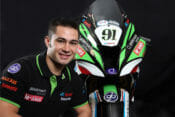That’s a wrap. After many trips to the track, many gallons of fuel burned, and many “which one is the best” discussions, we finally came to a conclusion and thus wrapped up your annual Cycle News 450 Motocross Shootout. And it was a close (well, from second place on back, that is).
The contestants were all the usual players: the all-new Kawasaki KX450F, KTM 450 SX-F and Husqvarna FC450, the revised Honda CRF450R and Yamaha YZ450F, and the unchanged Suzuki RM-Z450. No 350Fs or 250 two-strokes here, just the heavy artillery.

When we do our shootouts, we ride the bikes just how you’d get them right off the showroom floor. We don’t change tires, handlebars or grips, nothing. We do slap on some graphics, but that’s just to make them look pretty for the photos. All we do is play with suspension clickers and ride height, and try not to get too carried away with mapping—that can get a little involved and time consuming with all of the variables that almost all of them have to offer, so we focused mostly on the base ECU settings of each motorcycle for this shootout. And for the sake of space, we will focus on how these bikes perform and stack up against each other on the track and not so much on all of the technical details and changes, since we’ve already done that with each of these bikes in past issues.

We also selected a number of riders with varying skills to help evaluate each machine, and then rode them on as many different tracks as possible.
Alright, let’s cut to the chase…
*************************************************
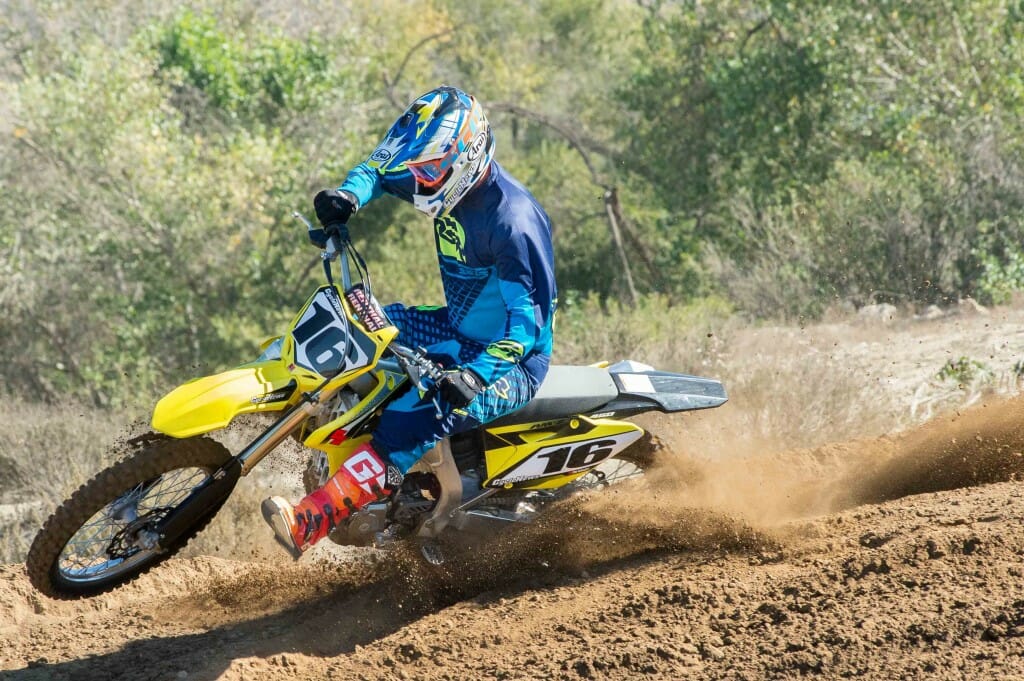
6th PLACE
SUZUKI RM-Z450
HIGHLIGHTS:
Showa SFF-TAC air forks
Holeshot assist
ECU couplers
IMPORTANT NUMBERS
Max Horsepower: 50.73 hp @ 9,200 rpm
Max Torque: 33.30 lb-ft @7,800 rpm
Weight (full fuel): 246 lbs.
Seat Height: 37.6 in.
MSRP: $8749
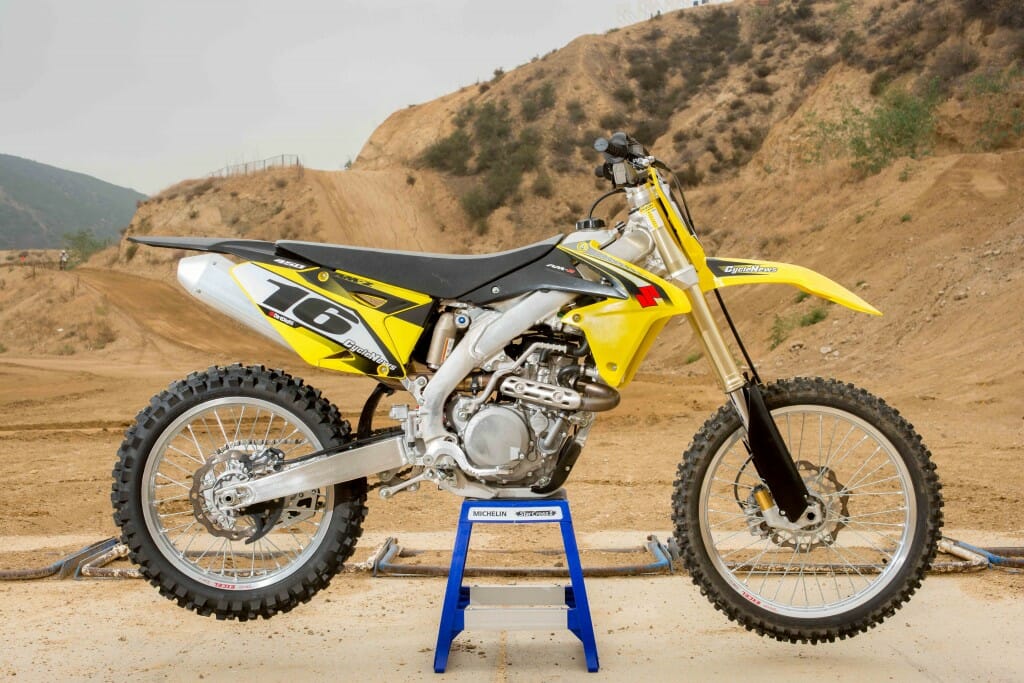
The Suzuki was a tough bike to place in our six-bike ranking. Opinions varied all over the place when it came to the great-turning RM-Z450. As a whole, some loved it, others, not so much. It really was a love-hate relationship with the Suzuki for most of our test riders. All, however, agreed that the bike is still the best-turning motorcycle of the group and has an excellent engine. It’s not the most powerful in its class but is still very torquey, robust and powerful enough overall to get the job done, and is relatively easy to control for a big-bore. We still like how you can easily adjust mapping via its pre-programed couplers, and it starts very easily, too.
We already mentioned that it’s still the best-turning bike of the group; problem is that over the years, the other bikes have been gaining ground on the Suzuki in this department, so its advantage here is getting narrower and narrower, which means this characteristic doesn’t quite make up for whatever shortfall it may have elsewhere nearly as much. Not good for the RM-Z.
One of these shortfalls is handling. The frame has a rigid feel, which means that hitting potholes on the track feels more like hitting curbs. We heard the word “harsh” a lot when our test riders where describing the RM-Z’s handling and overall feel. We love this bike on smooth tracks with big jumps—aka Supercross-style tracks—not so much on rough tracks like Glen Helen on a Thursday afternoon. The RM-Z also feels heavy compared to the other bikes and it is; only the YZ450F is heavier, but not by much.
The RM-Z’s suspension is not one of its strong points, although its Showa SFF-TAC AIR fork (which it got last year) is a big improvement over its previous spring fork (which we never liked at all). Overall, though, the RM-Z’s suspension lacks any plush feel and is somewhat difficult to dial-in. It takes a lot of trial and error getting this fork up to snuff; you can get there, but not as easily as with the other forks in this comparison. And then you really have to stay on top of them.
The RM-Z’s old styling didn’t impress our test riders any, but styling has nothing to do with performance on the track; this bike still rips, but it just didn’t impress or wow us as much as it used to, which most likely has to do with the other bikes just getting better by leaps and bounds.
PROS
Easy to turn
Broad power delivery
CONS
Complex forks
Rigid chassis
************************************************
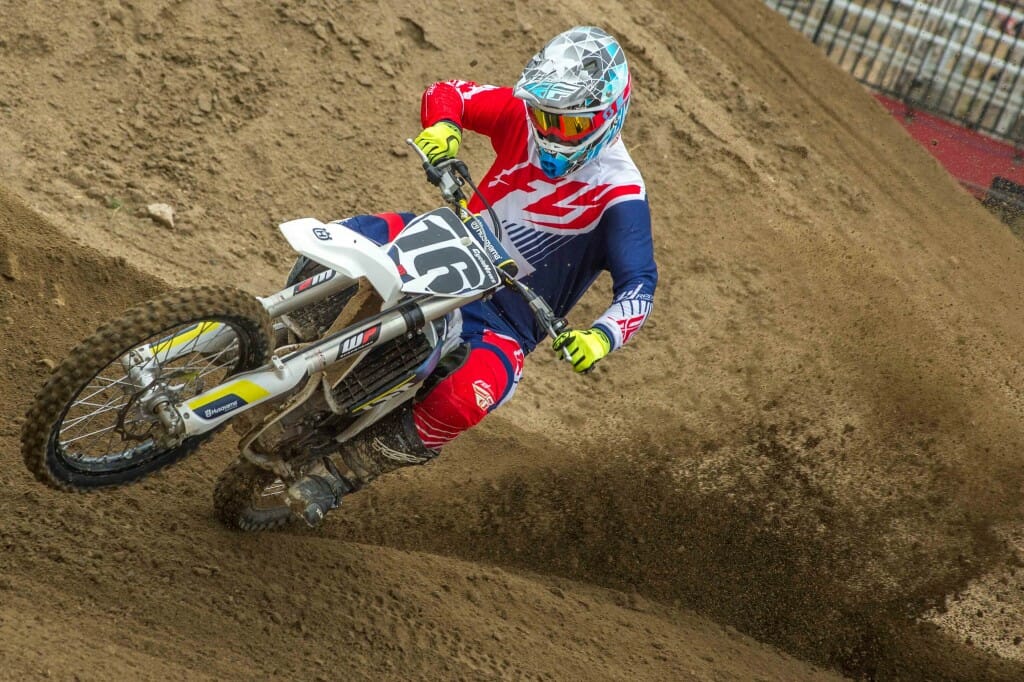
5th PLACE
HUSQVARNA FC450
HIGHLIGHTS
WP suspension
Chromoly-steel frame
Electric starting
Hydraulic clutch
Handlebar adjustable mapping
Holeshot assist
IMPORTANT NUMBERS
Max Horsepower: 55.54 hp @ 9,400 rpm
Max Torque: 34.81 lb-ft @ 7,100 rpm
Weight (full fuel): 241 lbs.
Seat Height: 38.8 in.
MSRP: $9399
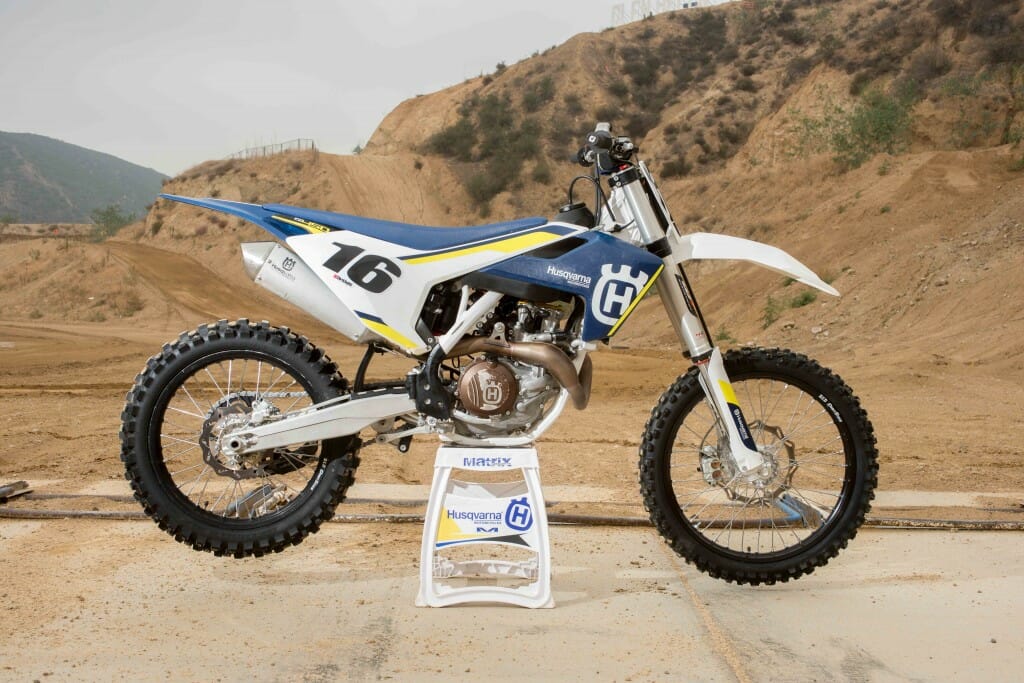
You would think that the KTM and Husky would rank the same; after all, they are the same bike, right? Not really. Even though both bikes come out of the same factory, they are slightly different, and those differences, as slight as they might be, can be felt on the track.
Technically, the Husky separates itself from the KTM a few ways: it’s fitted with MX52 tires versus the KTM’s MX32s, the Husky has an FIM-compliant muffler that is more restrictive, a composite subframe and integrated airbox, a Magura-made hydraulic clutch (KTM’s is Brembo-made), different GSK brake rotors, a softer seat and different D.I.D rims. Everything else is identical, even ECU mapping and suspension settings. What’s important, though, is that the MX52 tires, “plastic” subframe and muffler are all a little heavier than the KTM’s. Add it all up and the Husky weighs three more pounds than the KTM at 241 pounds. And the Husky has different (softer) suspension settings than the KTM, despite using the exact same WP components. These small differences add up on the track and gives the Husky a slightly different feel than the KTM, which our testers could notice.
Compared to the KTM, the Husky’s power delivery comes on softer (because of the more restrictive muffler and airbox) but progressively gets stronger as it goes. When you couple in its softer suspension and heavier overall weight, the Husky just feel slightly more sluggish by comparison and just doesn’t feel quite as refined as the KTM.
Although the Husky has one of the most powerful engines in the class, it’s one of the least exciting, meaning it doesn’t hit as hard as some of the others, but, on the flip side, this also means it hooks up better. Overall, though, the Husky has a great engine and its plenty fast; handlebar mapping has two settings (hard and soft), and it also incorporates launch control, which is funky to set, so you probably won’t use it. We also love the Husky’s electric starting, and its light pull hydraulic clutch.
Suspension is very good but a little soft for faster and heavier riders, but that’s not a big deal. The WP spring forks are very good, arguably better than the Kawasaki and Honda’s air forks.
The Husky is a very good handling machine; it turns quickly and with precision, and is stable at speed. Brakes are outstanding, too.
In a nutshell, we rated the Husky over the Suzuki mainly because of its electric starting, stronger motor, hydraulic clutch, better suspension and brakes, and more forgiving handling. (And, yes, it looks cooler, too.) It is, however, the most expensive bike in the group. The RM-Z has it beat by $670, and that’s pretty significant.
PROS
Light weight
Electric starting
Good suspension
Usable power delivery
Hydraulic clutch
Strong brakes
CONS
Soft power delivery
Heavy feeling
Most expensive of class
*********************************
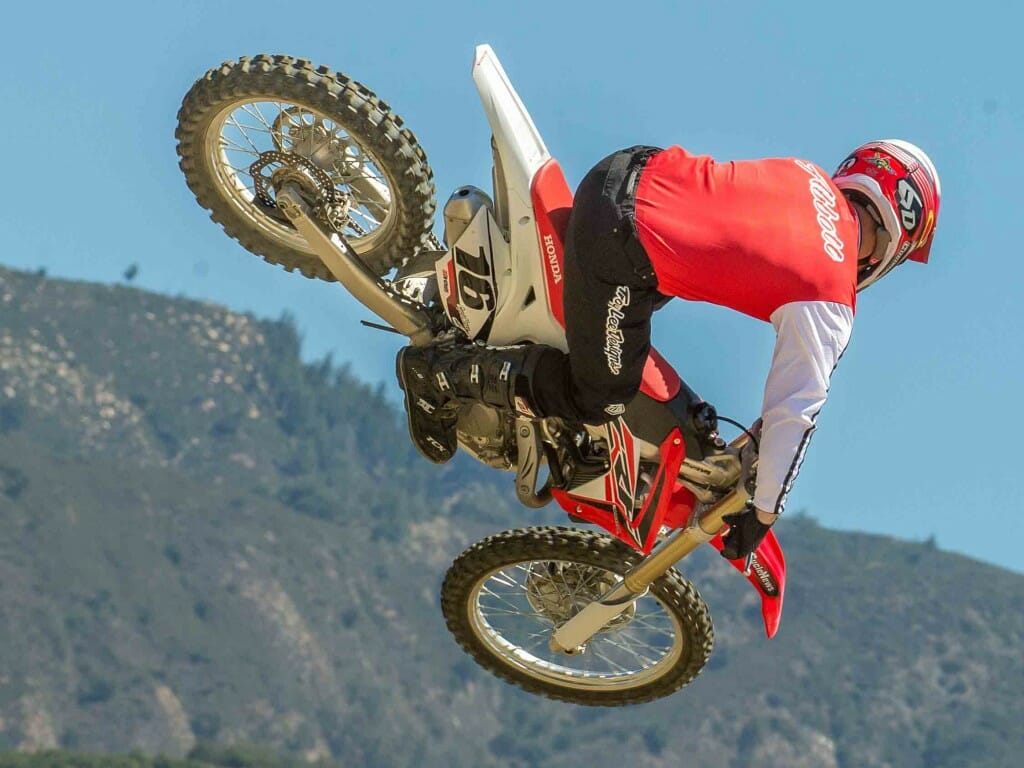
4th PLACE
HONDA CRF450R
HIGHLIGHTS
Dual exhaust
Unicam valve train
KYB PSF2 air forks
IMPORTANT NUMBERS
Max Horsepower: 51.44 hp @ 8,400 rpm
Max Torque: 33.49 lb-ft @ 7,900 rpm
Weight (full fuel): 244 lbs.
Seat Height: 37.5 in.
MSRP: $8699
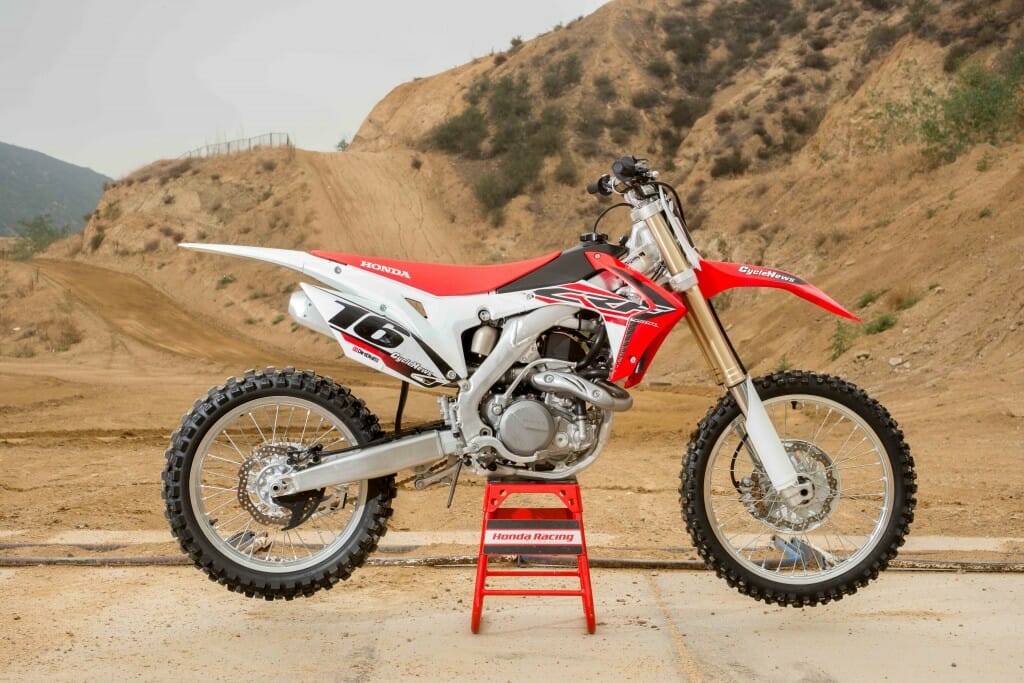
Despite getting just a few changes for 2016 (all to the chassis), the Honda is surprisingly improved over the 2015 model. The motor feels more lively, giving the bike an overall much-improved feel. But how could that be when they didn’t make any changes to the motor? Good question. As it turns out, the suspension changes—most notably new linkages—make the rear wheel hook up much better than before, so when you crack the throttle, it moves! It’s funny how a seemingly small change like that can completely change a bike’s personality.
The Honda was already one of the easiest and most comfortable of all of the 450s to ride, and it’s even easier now that the motor “feels” spunkier. Still, at 51.4 horsepower (8,400 rpm) the Honda is one of the weakest of the group, at least on paper. But a healthy dose of torque and an extremely user-friendly power delivery, work together to make the Honda’s engine surprisingly lethal. We simply like this motor because it doesn’t wear you out and works well on an extremely rough track, but we would like to have more power overall, especially on top. Mapping is also adjustable (three settings) via a convenient handlebar switch, but our testers generally preferred to leave it in “aggressive” mode.
We’re still not fans of the dual mufflers; they add weight, are twice susceptible to damage and harder to maintain.
Of all of the air-fork-equipped bikes, the Honda’s is probably the best in both performance and ease of adjusting. They have fewer chambers (one in each) to mess with compared to the Showa’s, and have plenty of damping adjustability. On the track, they do a good job soaking up the bumps but, like most air forks, they lack feel in the corners and don’t provide as good wheel-to-surface feedback as the other spring-fork-mounted bikes, especially the YZ’s SSS forks. Overall, though, the Honda has one of the best suspensions of the six bikes and is one of the best handling bikes, too. It’ll twitch now and then at speed, but we still consider it to be a very stable bike overall.
On the scale, the Honda isn’t the lightest bike in the class anymore but on the track, it still feels darn light because it is so well balanced. It’s easy to throw into the turns and make it do what you want in the air. The Honda also has excellent ergo and very good brakes.
We ranked the Honda above the Husky and Suzuki because of its light weight, agility and effective motor. Even though the Honda took a small step in the right direction it dropped back a spot in our rankings, unable to stay ahead of the all-new KTM or catch the already outstanding Yamaha and all-new Kawasaki. An overall stronger motor might’ve put it on the podium.
PROS:
Neutral ergos
Light and nimble feel
Excellent traction out of corners
CONS:
Down on top-end horsepower
Twin mufflers
****************************
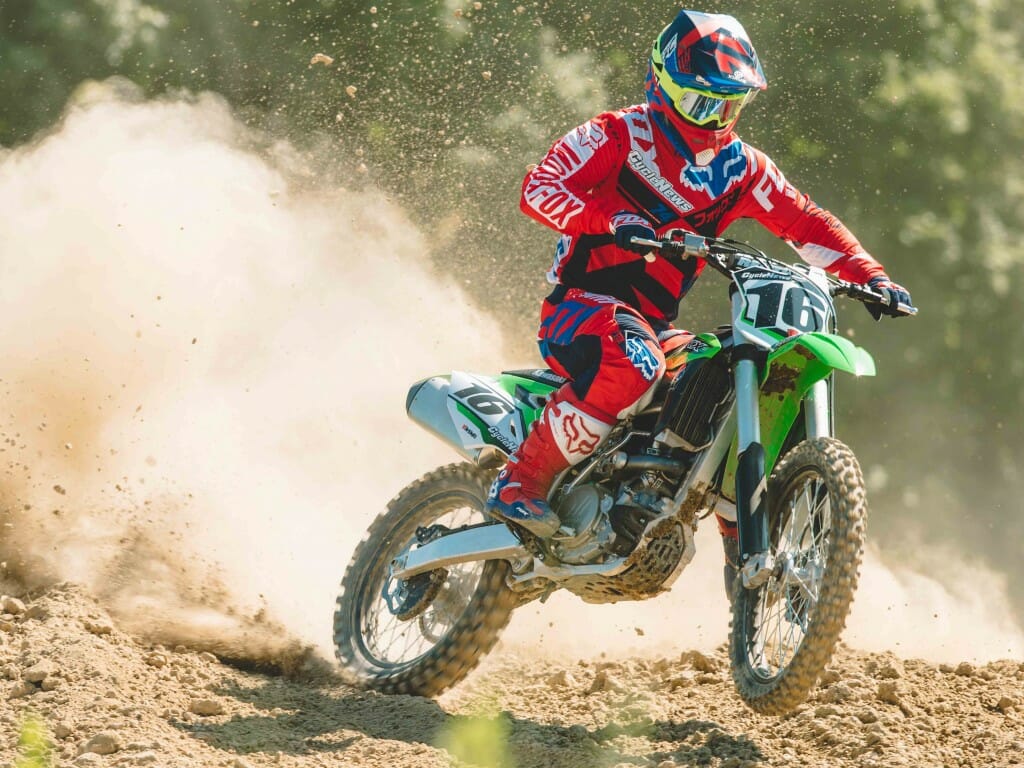
3rd PLACE
KAWASAKI KX450F
HIGHLIGHTS
Showa SFF-TAC air forks
Adjustable footpegs
Launch Control
ECU couplers
IMPORTANT NUMBERS
Max Horsepower: 53.09 hp @ 8,700 rpm
Max Torque: 34.13 lb-ft @ 7,700 rpm
Weight (full fuel): 241 lbs.
Seat Height: 37.8 in.
MSRP: $8799
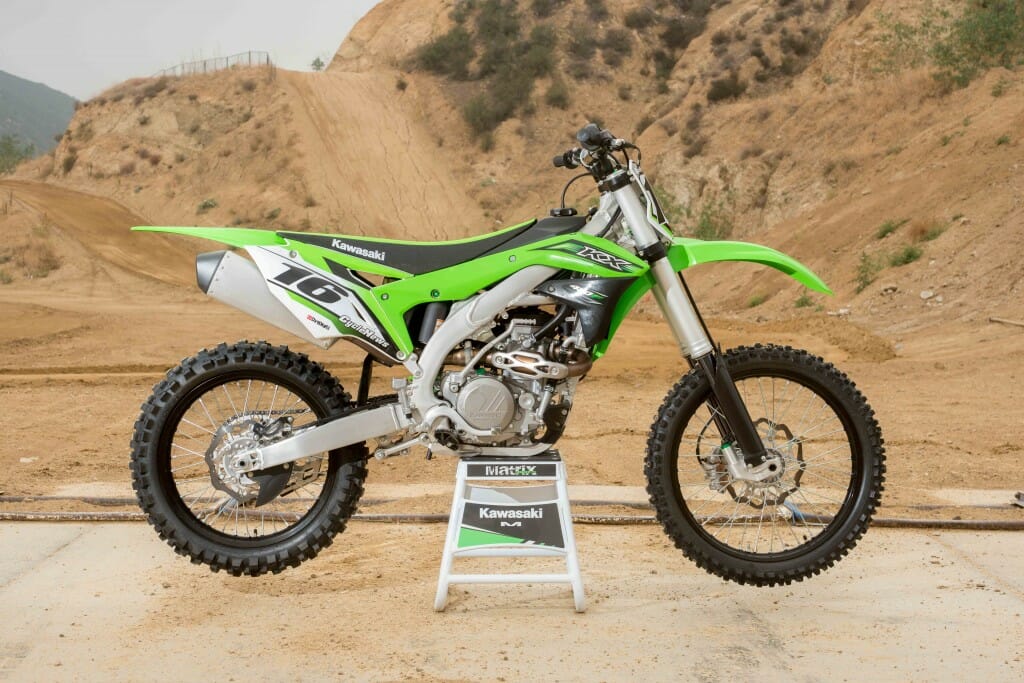
We’ve always been a big fan of the Kawasaki KX450F over the past 10 years. It was the king of the class until Yamaha finally worked out the bugs and polished its reversed-cylinder YZ in 2014. In hopes of regaining the crown, Kawasaki completely redesigned its KX450F for 2016 but couldn’t quite catch the YZ and actually got passed by the also-redesigned KTM in our comparison. This is hard to believe, even for us, because the KX is such an improved machine. But so is the KTM.
The Kawasaki is slimmer, lighter and easier to ride. The new engine, with updated mapping, is still very powerful and the overall package doesn’t have that monstrous feel as before.
The engine may not have a ton of peak horsepower but it has all the power you’ll ever need, really. The bottom-to-mid delivery is strong with more torque and less explosion compared to previous years, which in reality is a good thing. All this does is give the rider more control. While the top-end might sign off sooner than KTM, Husky and Yamaha’s, the Kawasaki can still get the job done. But for some, they miss that top-end over-rev. None of us, however, missed the KX’s ear-splitting exhaust note. Kawasaki says it’s quieter, we say it’s not.
Overall the suspension action is improved over previous years although the rear end doesn’t feel as planted as the Honda, KTM or Husky’s. The Showa air forks on the Kawasaki do feel better on the new chassis design but they require the most work to dial in compared to the rest. Even though this is the same fork that’s in the Suzuki, it comes set up from the factory a little differently, and seems to work a little better—at least on the KX. Dialing in these forks can be a little tricky. It probably wouldn’t hurt Kawasaki (and Suzuki, for that matter) to offer some kind of fork seminar to every person who buys a KX450F to explain how to adjust these complex units.
The Kawasaki still holds the title for the most adjustable motorcycle of the group. The KX is the only bike with adjustable footpegs and also has multi-way adjustable handlebars. Kawasaki now offers a slick new handheld engine tuner (sold separately), so you can easily fine-tune the engine’s ECU. It also has, of course, launch control.
When it came down to the final placement of the KX450F it was in a gloves off brawl between it and the KTM. Both bikes are impressive and both had their strong points, but unfortunately for the Kawi, the KTM edged it out for the final spot on the podium. Pretty much the deciding factor was the KTM’s broader powerband, better overall tractability, amazing brakes, lighter weight and electric starting. But, in the real world, both bikes are amazing and their positioning could’ve gone either way.
PROS
Strong yet manageable power delivery
Solid chassis that’s easy to control
Wide range of adjustability
CONS
Complex forks
Loud exhaust
**********************************
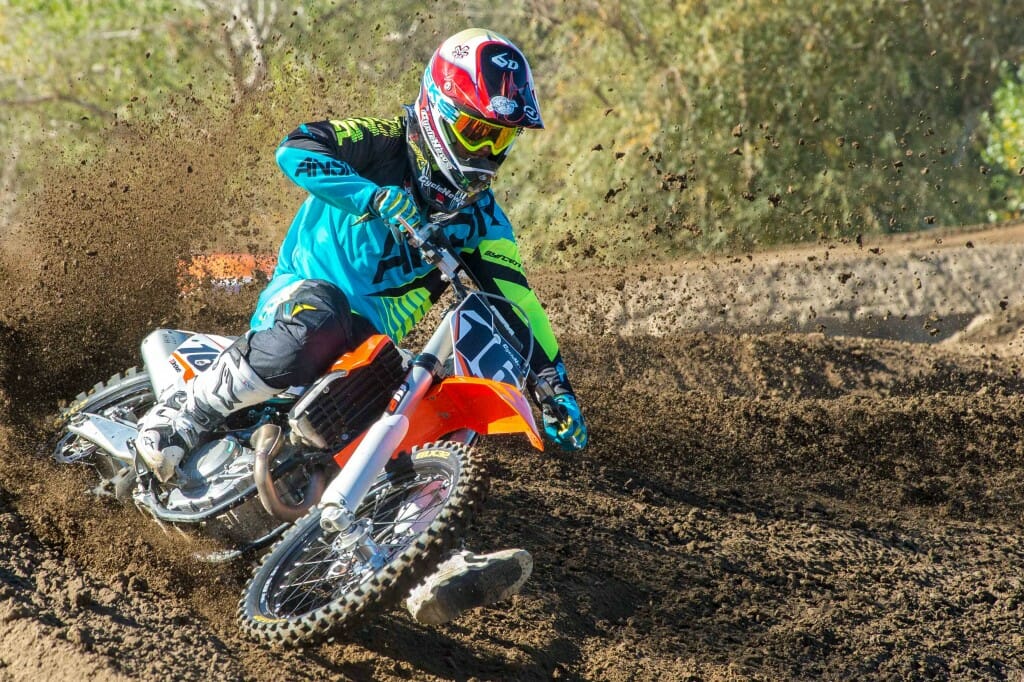
2nd PLACE
KTM 450 SX-F
HIGHLIGHTS
Chromoly-steel frame
WP suspension/coil spring forks
Electric starting
Hydraulically operated clutch
IMPORTANT NUMBERS
Max Horsepower: 54.31 hp @ 9,400 rpm
Max Torque: 34.38 lb-ft @ 7,600 rpm
Weight (full fuel): 239 lbs.
Seat Height: 37.8 in.
MSRP: $9299
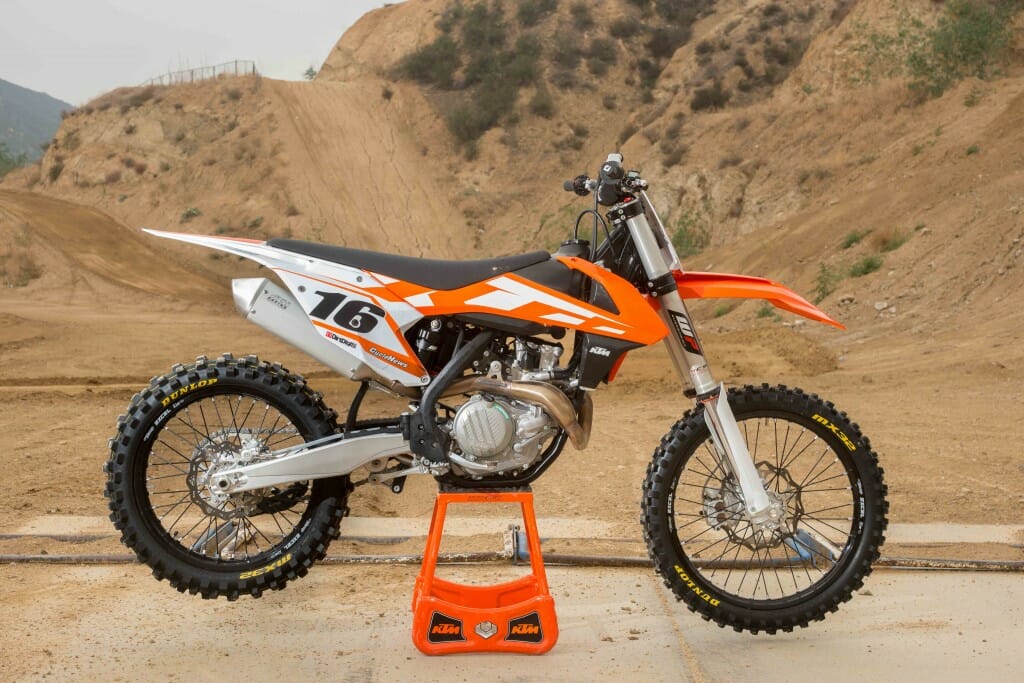
KTM left no stones unturned when redesigning its 450 SX-F, which is basically the same bike as the 2015 limited edition Factory Edition, the base model for Ryan Dungey’s championship-winning factory bike. The new KTM is remarkably light, compact and slim. It’s still two pounds lighter than the Husky and Kawasaki, five pounds lighter than the Honda (which used to be the lightest bike in the class), seven pounds lighter than the Suzuki and 10 pounds lighter than the Yamaha. And it managed this with electric starting! Amazing.
The KTM has evolved into one of the best-turning bikes of the group. It’s a point and shooter, and you never have to second-guess what the front end and the rest of the bike is going to do. Whether you’re railing a berm or diving to the inside, the KTM’s front end doesn’t twist or slide and has a very fluid feel. It’s worth noting that the KTM is the only bike that comes fitted with lighter Dunlop MX32s, the rest MX52s.
Compared to previous KTM models the power delivery is noticeably mellower, but it still has gobs of torque. It may not be as strong off the bottom as the Yamaha or Kawasaki but the KTM has a more controlled feel, which means you work less so you can ride harder, longer. You do notice more vibes on the KTM versus the Japanese bikes. Like the Husky, it offers launch control but it’s tricky to operate; accidently twist the throttle when it’s engaged and it cancels itself. Weird. Can you not blip the throttle—not once—while anxiously waiting for the gate to drop? Didn’t think so.
The KTM handles great. You can charge the rough sections with confidence, knowing it will maintain a straight line and not do anything scary.
The 450 SX-F has come a long ways in the suspension depart over the years. This is by far the best-suspended 450 SX-F ever. WP has stepped up its game and has provided KTM with its best suspension components yet. The latest-generation WP 4CS fork works well right out of the crate and is easy to adjust and maintain. It’s at minimum on par with the other air forks but, like all the rest, can’t touch the KYB SSS spring fork on the Yamaha.
The KTM is, like the Husky, a comfortable bike (but the seat is a little on the firm side) and feels a tad compact in the saddle. That’s not necessarily a negative thing, just an observation.
Our test riders also noted the KTM’s awesome brakes, light-pull clutch, smooth-shifting transmission and impressive looks (but it would look better with an orange frame, like the Factory Edition).
There wasn’t much that set it apart from it and our shootout-winning YZ450F.
PROS
Light weight
Compact chassis
Hydraulic clutch
Electric start
MX32 tires
CONS
Pricey
Weird launch control design
**************************************

1st PLACE
YAMAHA YZ450F
HIGHLIGHT
Reversed cylinder
Reward-slanted cylinder
KYB Speed Sensitive System (SSS) coil/spring fork
IMPORANT NUMBERS
Max Horsepower: 52.58 hp @ 9,400 rpm
Max Torque: 32.14 lb-ft @ 7,500 rpm
Weight (full fuel): 249 lbs.
Seat Height: 38.0 in.
MSRP: $8590
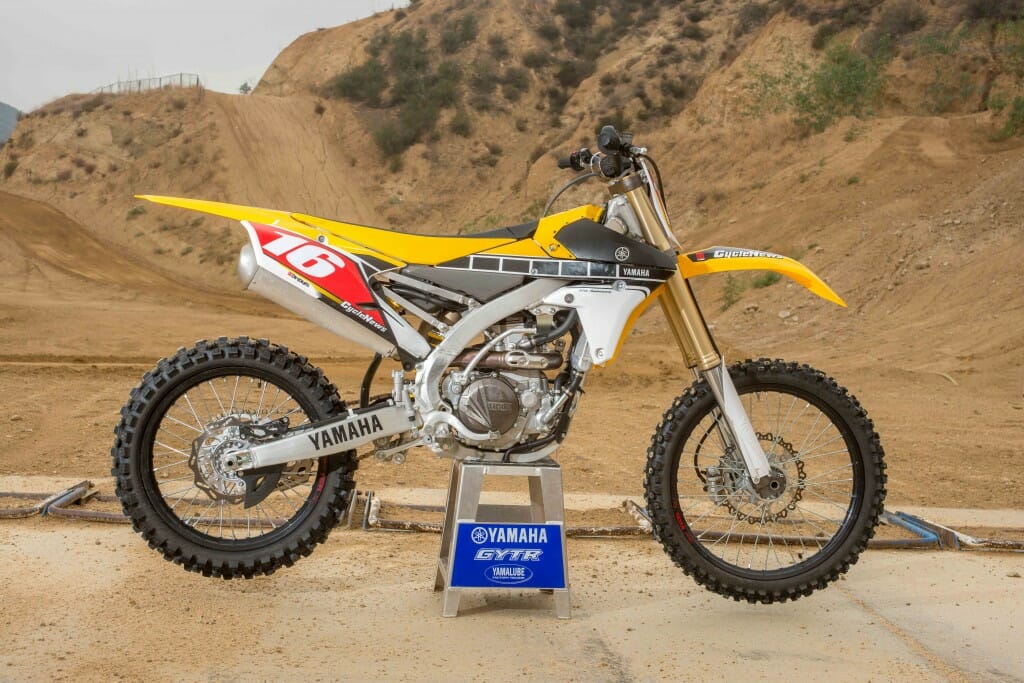
Our defending champ (hence the red backers on our Yamaha), the Yamaha YZ450F, saw only a few minor refinements in both the engine and chassis departments for the 2016 model year, but they made noticeable and improved differences on an already outstanding package.
This year’s power delivery has better roll-on performance off the bottom while still maintaining a strong mid and top. Overall the engine is a bit tamer compared to last year’s hard-hitting mill, but it has stronger bottom and midrange than almost all of the other 450s. It is without a doubt the most responsive motor of the group. Clutch action is very good and, although Yamaha’s shifter has a longer throw than some of the others, its engagement is the most positive. Almost all of our test riders simply said the Yamaha had the best all-round motor.
Yamaha is sticking to its guns when it comes to the YZ’s KYB SSS spring forks. They flat out said they’ll change it when they feel something else better comes along for the general public. That time hasn’t come along yet, and we couldn’t agree more. These forks simply work great and they’re easy to maintain and adjust. Why change?
The back end works just as good as the front, making the YZ450F still the best-suspended bike in its class. Nothing can touch it. And when you combine the YZ’s class-leading suspension with its outstanding chassis and solid motor, you have one overall package that can’t be beat, not even the all-new KTM, Husky or Kawasaki.
Plus, there really isn’t anything that the YZ doesn’t do as well or exceed when it comes to the other bikes. It has great brakes, a solid clutch, excellent components (handlebars, grips, levers, etc.) and has a great reputation for reliability. Plus, it’s the least expensive bike of the six at $8590. What a deal.
The Yamaha, however, is not perfect. It should call Jenny Craig for an appointment, exhaust is loud, it feels a little wide between your legs and it isn’t the sharpest cornering bike of the group; in fact, they all turn better than the Yamaha, but the YZ isn’t so far behind them that it really matters. You learn to adapt. But turning is better than the 2015 model. In fact, both cornering and stability have been improved, and they did that by changing the triple-clamp offset and lightening the shock spring rate, which allows the Yamaha’s rear end to have a more settled feel down the straights and a more balance feel in the corners.
In the end, our test riders had no problems voting the YZ450F as number-one again, but added that the margin of victory isn’t as much as it was because of the much-improved KTM and Kawasaki. And the Husqvarna is just a muffler and a pair of tires away from joining the green and orange bikes.
Contrats to Yamaha for three-peating our Cycle News 450 MX Shootout.
PROS
Best suspension, excellent forks
Strong/lively power delivery
Great reputation for durability
Available in two color options
Lowest MSRP
CONS
Widest shrouds of all bikes
Overly loud
Vague cornering
*********************
You can also view our 2016 450 MX Shootout in our magazine by clicking HERE
